Fig. 8.1
Start page providing the task list SEARCH, EDITORIAL BOARD, CONTACT, SUBMISSION, HANDBOOK, DOWNLOAD, LINKS, LANGUAGE, e-LEARNING, and LOGIN, showing the portraits of the editorial board, the anatomical order of ophthalmic diseases, the direct link to the Facebook channel, the area of “keyword-associated information” as advertisement, and latest news (Reprinted with permission from Verlag ONJOPH.COM)
8.3.3 Mode of Medical Case Presentation
In all four access channels, the case reports were presented by authors, diagnosis, comment, images, ICD code, and keywords. Each case was commented briefly and keywords were provided. More than 2,000 cases with about 9,200 pictures were accessible comprising the whole spectrum of ophthalmology. Navigation through the atlas was adapted to the well-known “arborization structure” of the Windows Explorer. For a better overview each picture was first displayed as a thumbnail (Fig. 8.2). Two different resolutions were provided, which were saved in JPEG format of 300 dpi for a quick overview and as a high-resolution image of 650 dpi. The high-resolution images were only available after registration. Each case and picture was provided with information about the author and institution. By means of an electronic watermark, the origin of the atlas pictures remained verifiable and detectable at any time.
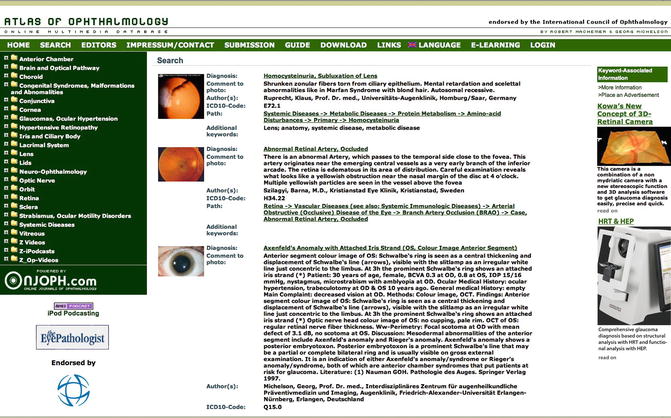

Fig. 8.2
Navigation through the atlas was adapted to the well-known “arborization structure” by Windows Explorer. For a better overview, each image was first displayed as a thumbnail (Reprinted with permission from Verlag ONJOPH.COM)
8.3.4 Order of Cases
The cases were classified according to anatomical criteria: lids, conjunctiva, cornea, and so on. All cases were arranged strictly in the related folders according to a diagnosis key (Fig. 8.3). Additionally, in the Atlas 2.0 version, cases were presented by date of publishing (issue, according to the date of publication).


Fig. 8.3
Image depicts the placement of the advertisement with “keyword-associated information.” The advertisement was presented by title, image, short text, and link (Reprinted with permission from Verlag ONJOPH.COM)
8.3.5 Navigation and Search Function
A fast query function and a complex search engine existed exhibiting several search modes. Cases and pictures could be searched by author, diagnosis, ICD code, and keywords.
8.3.6 Languages
Text and navigation was in Arabian, German, English, Russian, and Spanish, and, in part, in Portuguese, Japanese, and Chinese language. For each item of the atlas, the desired language could be selected. The total navigation, the diagnoses, and the comments were drafted multilingual. The atlas was presented completely in five languages, German, English, Spanish, Russian, and Arabian. Translation into the languages Portuguese, Chinese, and Japanese was partially completed. The translators were for English, H.E. Voelcker and Juliane Schlomberg; for Portuguese, Renato W. Damasceno; for German, Juliane Schlomberg; for Spanish, Raphael Cortez; for Chinese, Yanyan Koenig, Wu Liu, Qisheng You, and Liang Xu; for Russian, Alla Lisochkina; and for Arabic, Abdullah A. Laftal, Ahmad Wali, Abdullah Wali, Abdulwahed Mohammad Al-Amri, Osamah Al-Ghamdi, Mohammad Alhussain Alneamy, Ziyad Alhawali, Mohammed Alhefzi, Turki AL-Aziz, Muayyad Alhefdhi, Saqer Al-Deraan, Turki Dhafer Al-Shehri, and Mohammed Hammad ALMakady.
8.3.7 Submission
Only by the access channels http://www.atlasophthalmology.com and Atlas 2.0 version, the submission of cases was performed by documenting author(s), institution, email address, diagnosis, ICD-10 code, comment, and keywords. Online submission was organized as simple upload of pictures, authors, diagnosis, ICD code, and short comment. The entire process of peer review and publication was conducted online. Ophthalmologists of more than 156 countries submitted cases.
8.3.8 Review of Submitted Cases
Every case was reviewed by one of the editors before publication. Editors were G.O.H. Naumann [11], H.E. Völcker, D. Huang, B. Seitz, and G. Michelson. All cases and pictures submitted for publication underwent the online review process by the editors. Only accepted cases were published. The process of submission and review was effected online.
8.3.9 Certified Medical Education
A continuous medical education was implemented in the channel www.atlasophthalmology.com. The medical education tool was generated within an official cooperation with the “Bayerische Landesärztekammer.” The e-learning system offered 21 modules. Every module contained medical cases of a distinct anatomical area of the eye (e.g., sclera, cornea, choroid). Per module three official CME points could be reached. To test the educational success, the user was asked to mark the correct diagnosis of ten clinical images, which were shown with five optional diagnoses. Only one of these five suggestions was the correct diagnosis. When more than 7 out of 10 questions were answered correctly, the users have reached 2 CME points. When all 10 questions were correctly answered, in total 3 CME points were released. After finishing the test, the certificate was sent to the user by email as a pdf document. The cost to perform one module was 4.99 €, payable through PayPal or by a voucher. The voucher contained a 12-digit number allowing the entrance to the e-learning system to complete one module.
8.3.10 Funding
Funding was predominantly by voluntary dedication. The funding of the open-access journal Atlas of Ophthalmology resulted from the voluntary work of editors, reviewers, authors, and coworkers and in part by support through advertisement by using the “keyword-associated information system.”
8.3.11 Advertisement
In the access channel www.atlasophthalmology.com, industrial advertisement was presented as “keyword-associated information.” The purpose of this service was to offer additional information to the selected medical case which was searched by the user. This information was displayed along with the search results. When a visitor searched images using distinct keywords, only an advertisement coupled with these keywords became visible for this user. The “keyword-associated information” appeared in the right column of the website. The advantage from this type of advertisement was that the information was only presented to the users interested in images which were coupled with the keywords of the advertisement. The “keyword-associated information” format included headline, small image, text, and a link to a website. Figure 8.3 depicts the placement of the “keyword-associated information.”
8.3.12 Additional Access Channels
The second access channel of the social media platform was Facebook. Under www.facebook.com/AtlasOphthalmology, a selection of interesting cases was presented as case of the week, with only one image per case and exclusively in English language. Here the case was presented in a shortened version with only one image and a link to the original website atlasophthalmology.com presenting the complete case. Figure 8.4 showed a typical case presentation in Facebook. The third access channel to the medical cases was the iPhone and iPad application, presenting all published cases in English, German, Spanish, Russian, and Arabian language. These applications enabled a fast and mobile search of ocular diseases. The applications allowed a search for cases using diagnosis, ICD, or authors. The cases were presented by diagnosis, ICD code, comment, authors, and pictures given in middle or high resolution. Figures 8.5 and 8.6 depict the screenshots of the iPad and iPhone application, respectively. The applications could be downloaded from iTunes under the keyword “atlasophthalmology” – https://itunes.apple.com/us/app/atlas-of-ophthalmology/id448650383?mt=8.
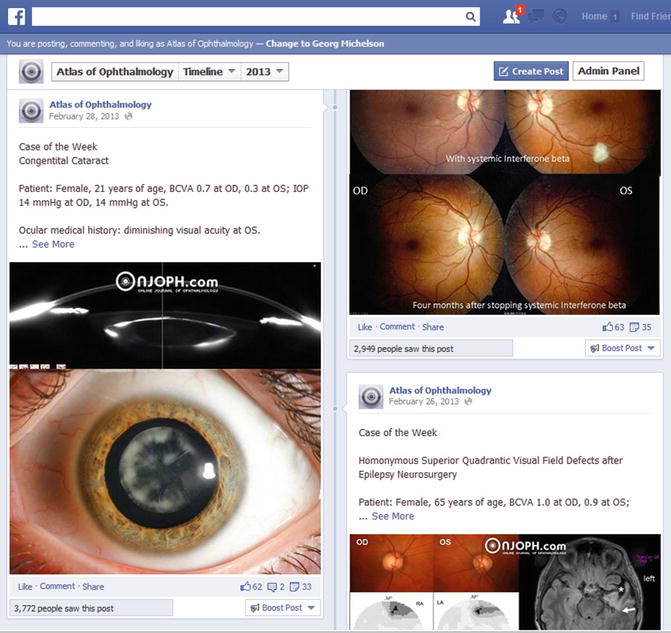
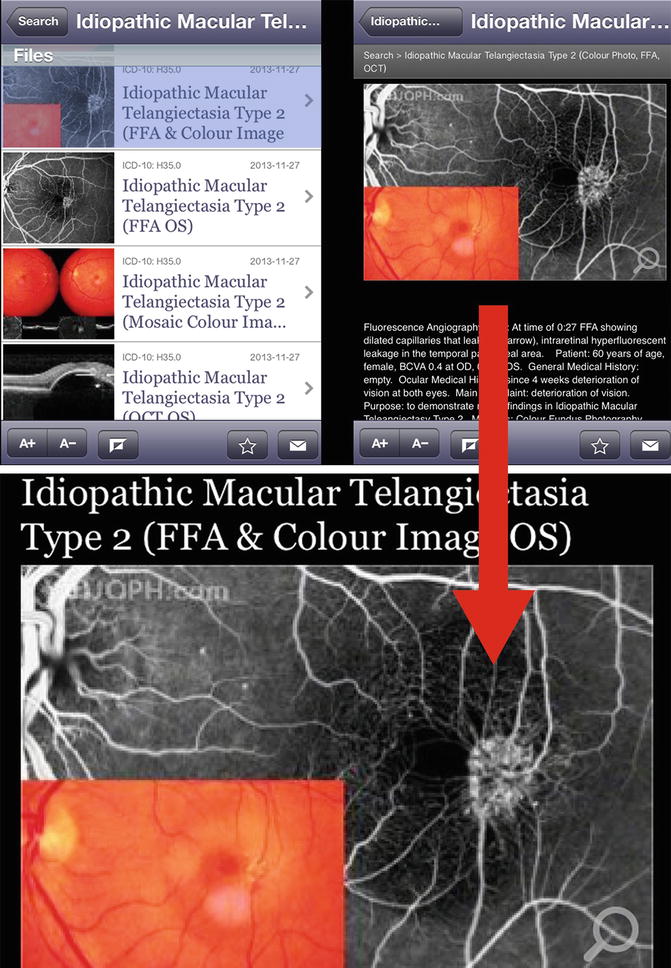
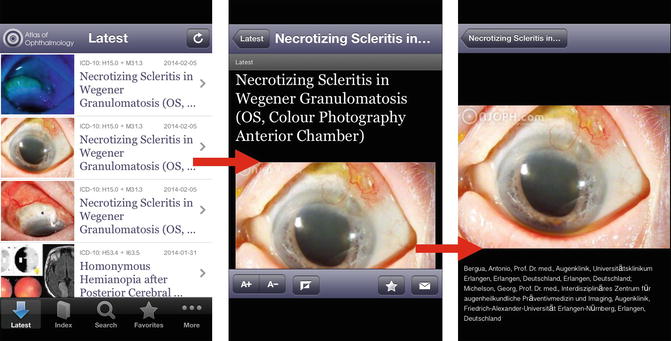

Fig. 8.4
The access channel Facebook presented the cases in a shortened version with a link to the complete case presentation under www.atlasophthalmology.com (Reprinted with permission from Verlag ONJOPH.COM)

Fig. 8.5
iPad application: showing two screenshots of the iPad app “Atlas of Ophthalmology.” The cases were presented by diagnosis, ICD code, image with comment, and authors. The app allowed to search for cases under diagnosis, ICD, and authors. All images were given in a middle or high resolution (Reprinted with permission from Verlag ONJOPH.COM)

Fig. 8.6
Screenshots of the iPhone app. The cases were presented by diagnosis, ICD code, image with comment, and authors. By using the iPhone app, a fast and mobile search of ocular diseases can be performed (Reprinted with permission from Verlag ONJOPH.COM)
The fourth access channel of the social media platform was the Atlas 2.0 version. Interactive and collaborative web applications offered new opportunities for reaching patients and other health-care consumers by facilitating information creation, sharing, and retrieval. Beginning in 2014 all medical cases were presented by the Web 2.0 technique, allowing a barrier-free access to the cases, independently of the browser or the used device such as a PC, tablet, or mobile phone. This technique enabled a full interactivity with the opportunity to discuss selected cases. The Atlas 2.0 version allowed to perform all process steps as submission, review, and publication according to MEDLINE and PubMed rules. Figure 8.7 represents screenshots of the Atlas of Ophthalmology 2.0.
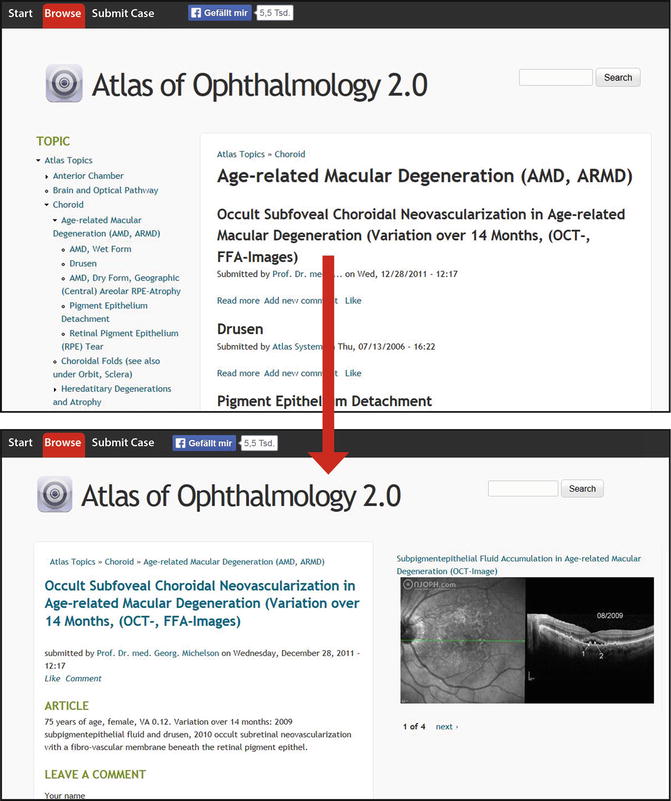

Fig. 8.7
Atlas of Ophthalmology 2.0: Using Web 2.0 technology navigation through the cases of Atlas 2.0 was possible by anatomical order or by issues according to the date of publication. Registered visitors could leave comments to distinct cases (Reprinted with permission from Verlag ONJOPH.COM)
8.3.13 Registration
To view images in the best resolution and to get permission to use images, a personal registration was needed. Only with an ID and password were these services available.
Stay updated, free articles. Join our Telegram channel

Full access? Get Clinical Tree


